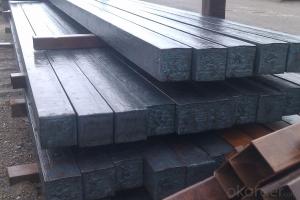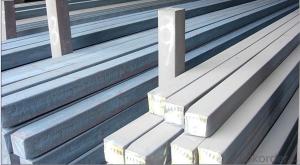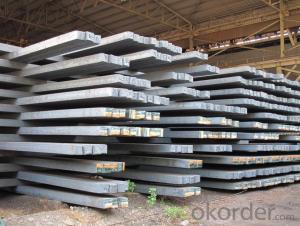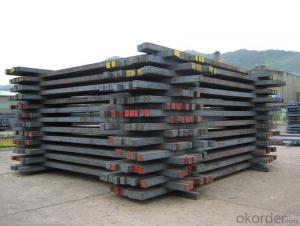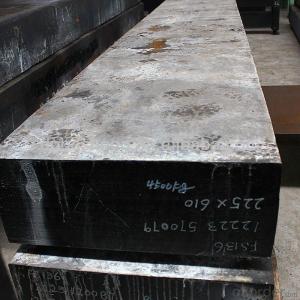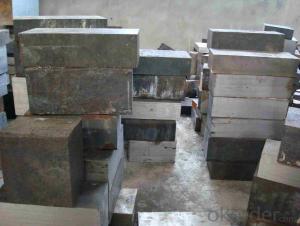Prime square alloy steel billet 135mm Q235
- Loading Port:
- Shanghai
- Payment Terms:
- TT OR LC
- Min Order Qty:
- 100 m.t.
- Supply Capability:
- 10000 m.t./month
OKorder Service Pledge
OKorder Financial Service
You Might Also Like
Structure of Prime square alloy steel billet 135mm Q235

Description of Prime square alloy steel billet 135mm Q235
Manufacture Progress:HRC-CRC-GALVANIZED-COLOR COATED
Application : Construction, electrical, transportation, steel plant, composite board plant, steel tile factory
Payment & Shipping Terms:T/T ,L/C, and FOB CHINA
Minimum Order Quantity: 25Tons
Packge Type: Moisture-proof paper inner,Steel outside,Bundle by steel rope.
Package in Container : Wood as a foot pad, wire rope reinforcement,PPGI steel coil tied together by steel rope.

Main Feature of Prime square alloy steel billet 135mm Q235
Uncoated CR steel sheet
With the features of in line with the international highest standards in demension and shape, excellent surface finish and properties, the products are mainly used in home appliance and automobile industries.
Galvanized steel sheet(include HDG and EG)
With the features of good corrosion resistance, the products are mainly used in automobile, home appliance, electronics, building and machinery manufacture industries, etc.
Precoated steel sheet
With the features of enviromental protection and good processablility, long lasting surface durability, rich in colors, the products are maily used in building, home appliance and furniture industries, etc.
Applications of Prime square alloy steel billet 135mm Q235
1) Excellent corrosion resistance: The zinc layer provides a good protection of Pre-painted Galvanizeed Steel Sheet.
2) High heat resistance: The reflective surface of the material aids in efficiently reflecting the sunlight away and in turn reducing the amount of heat transmitted. The thermal reflectivity converts into energy savings.
3) Aesthetics: Pre-Painted Galvanized steel sheet is available in plethora of patterns and multiple sizes as per the requirements that given by our customers.
4) Versatility: can be used in the various areas.

Specifications of Prime square alloy steel billet 135mm Q235
Product | Billet |
Material Grade | SGCC / SGCH / DX51D+AZ, etc |
Thickness | 0.6-3.0mm |
Width | 500-1500mm |
Tolerance | Thickness: +/-0.02mm , Width:+/-2mm |
Zinc-coating | Z30-150g/m2 |
Technique | Raw material: Hot rolled steel coil --> Cold rolled_>hot dipped galvalume |
Surface | Dried, Chromated, Unoiled |
Spangle | Regular spangle , small spangle, zero spangle |
ID | 508MM 610MM |
Coil weight | 1-25MT |
Export package | Cardboard inner sleeves, Waterproof paper, galvanized steel covered and steel strip packed |
FAQ of Prime square alloy steel billet 135mm Q235
We have organized several common questions for our clients,may help you sincerely:
1. How Can I Visit There?
Our company is located in Tianjin City, China, near Beijing. You can fly to Tianjin Airport Directly. All our clients, from home or aboard, are warmly welcome to visit us!
2. How Can I Get Some Sample?
We are honored to offer you sample.
3. Why choose CNBM?
we always fix steel produce in container well to make it safe arrive at destination port
we always provide best and professional forward service for our buyer
we always apply 14days free detention for our buyers container in destination
we provide one set After-sales service for our buyer
we provide China inland steel market price report
we help our buyer become number one in local market .
- Q:The role of carbon content in steels
- Therefore, the carbon content determines the use of steel: low carbon steel (carbon content < 0.25%), commonly used as extrusion and stamping materials; carbon steel (carbon content < 0.6%), commonly used as mechanical parts; high carbon steel (carbon content > 0.7%), commonly used tools, tool and mould etc..
- Q:What are the different types of steel billet packaging?
- There are several different types of steel billet packaging that are commonly used in the industry. 1. Bundles: Bundles are one of the most common types of packaging for steel billets. In this method, several billets are tightly bound together using steel straps or wire rods. This helps to secure the billets and prevent any movement or damage during transportation or storage. 2. Wooden crates: Wooden crates are another popular packaging option for steel billets. These crates are usually made of sturdy wooden materials and are designed to provide maximum protection to the billets. They are typically reinforced with steel bands or straps to ensure the billets remain secure. 3. Steel cages: Steel cages or racks are commonly used for packaging steel billets. These cages are made of steel and are designed to hold multiple billets at once. They provide a sturdy and secure packaging solution and allow for easy handling and transportation. 4. Plastic wrapping: In some cases, steel billets may be wrapped in plastic film or shrink wrap to provide protection against moisture and corrosion. This method is often used when the billets are being stored or transported in a controlled environment. 5. Custom packaging: Depending on specific requirements, steel billets may also be packaged in custom-made containers or packaging solutions. These can include specialized crates, boxes, or containers designed to fit the dimensions and weight of the billets, ensuring maximum protection during transportation and storage. Overall, the choice of steel billet packaging depends on factors such as the size and weight of the billets, transportation method, and desired level of protection. Each type of packaging has its own advantages and is chosen based on the specific needs of the industry and the customer.
- Q:What are the different types of tests conducted on steel billets?
- There are several different types of tests that are conducted on steel billets to ensure their quality and suitability for various applications. These tests are essential in determining the mechanical properties, chemical composition, and integrity of the steel billets. 1. Chemical Composition Analysis: This test involves examining the chemical composition of the steel billets to ensure that they meet the required standards and specifications. It measures the levels of various elements such as carbon, manganese, silicon, sulfur, and phosphorus. 2. Tensile Test: This test measures the tensile strength, yield strength, and elongation of the steel billets. It helps determine the ability of the steel to withstand pulling forces without breaking. 3. Hardness Test: This test determines the hardness of the steel billets, which is essential in evaluating their resistance to wear, deformation, and penetration. Commonly used hardness tests include Brinell, Rockwell, and Vickers tests. 4. Impact Test: This test measures the toughness and ability of the steel billets to absorb energy under impact or sudden loading conditions. It helps determine their resistance to fracture and cracking. 5. Ultrasonic Testing: This non-destructive test uses high-frequency sound waves to detect internal flaws or defects in the steel billets. It is commonly used to detect cracks, voids, and inclusions that may affect the structural integrity of the billets. 6. Dimensional Inspection: This test ensures that the steel billets meet the specified dimensional requirements, including length, width, and thickness. It ensures that the billets are suitable for their intended application and can be used in subsequent manufacturing processes without any issues. 7. Macroscopic Examination: This visual inspection involves examining the surface and internal structure of the steel billets using magnification. It helps identify any visible defects such as cracks, porosity, segregation, or any other irregularities. 8. Microscopic Examination: This test involves examining the microstructure of the steel billets using a microscope. It helps determine the grain size, presence of phases, and any abnormalities in the steel structure that may affect its properties. These tests collectively ensure that the steel billets meet the required quality standards and possess the necessary mechanical properties for their intended applications. They help ensure the safety, reliability, and performance of the steel billets in various industries such as construction, automotive, aerospace, and manufacturing.
- Q:How are steel billets tested for quality?
- To ensure that steel billets meet the necessary standards and specifications, a series of rigorous procedures are employed to test their quality. These tests play a crucial role in determining the mechanical properties, composition, and strength of the billets. Ultrasonic testing (UT) is a commonly used method to assess the quality of steel billets. This technique involves transmitting high-frequency sound waves through the billet and detecting their reflection using a receiver. By doing so, any internal defects or inconsistencies within the material can be identified. Another significant test is hardness testing, which involves measuring the surface hardness of the billet using techniques like the Brinell, Rockwell, or Vickers hardness test. This helps evaluate the billet's resistance to indentation and provides insights into its durability and strength. Chemical composition analysis is also vital in assessing the quality of steel billets. Samples are taken from the billet and subjected to chemical analysis to measure the concentrations of different elements present, such as carbon, sulfur, and manganese. This analysis verifies whether the billet meets the required composition standards. Furthermore, physical tests like tensile testing are conducted to determine the mechanical properties of the steel billets. This involves applying controlled force to the billet and measuring the resulting deformation or elongation. Tensile testing assesses the billet's strength, ductility, and other mechanical properties. Visual inspection by qualified inspectors is another crucial aspect of quality testing. They meticulously examine the billets for any surface defects, cracks, or irregularities that could impact their quality or performance. In conclusion, steel billets undergo a comprehensive range of testing procedures, including ultrasonic testing, hardness testing, chemical composition analysis, physical tests, and visual inspection. These tests are essential in ensuring that the billets meet the required quality standards, confirming their strength, composition, and overall quality before they are utilized in various industrial applications.
- Q:How are steel billets used in the production of wire rods?
- Steel billets are a crucial raw material in the production of wire rods. These billets, which are cylindrical in shape, serve as the starting point for the wire rod manufacturing process. The process begins with the heating of steel billets in a furnace to achieve the desired temperature for hot rolling. Once heated, the billets are passed through a series of rolling mills, where they undergo a process called hot rolling. This process involves passing the billets through a set of rollers that gradually reduce their diameter, while increasing their length. As a result, the billets transform into long, thin, and continuous wire rods. During hot rolling, the steel billets undergo plastic deformation, meaning that their shape changes under the application of heat and pressure. This process helps to align the internal grain structure of the steel, resulting in improved mechanical properties such as strength, ductility, and toughness. After the hot rolling process, the wire rods are typically coiled and cooled. They may then undergo further treatments such as pickling, surface coating, or heat treatment to enhance their quality and suitability for specific applications. Finally, the wire rods are ready to be used in various industries, such as automotive, construction, and manufacturing, for the production of a wide range of products, including wires, cables, nails, screws, and reinforcement bars. In summary, steel billets are transformed into wire rods through the process of hot rolling. This process involves heating the billets, passing them through rolling mills to reduce their diameter and increase their length, and then further treating and cooling them. The resulting wire rods are used in a multitude of applications, making them an essential component in the production of various products.
- Q:Can steel billets be extruded into different shapes?
- Certainly! Steel billets have the capability to be transformed into various forms through the process of extrusion. Extrusion, being a metalworking technique, involves the application of pressure to a steel billet via a die, thus resulting in the desired shape. To achieve malleability, the billet is heated to a specific temperature and subsequently pushed through the die through the utilization of either hydraulic or mechanical force. This procedure facilitates the production of an extensive array of shapes encompassing rods, bars, tubes, profiles, and even intricate geometries. It is widely employed in the manufacturing sector for the fabrication of diverse steel products catering to construction, automotive, aerospace, and numerous other applications.
- Q:What is the typical fatigue strength of a steel billet?
- The typical fatigue strength of a steel billet can vary depending on various factors such as the specific grade of steel, the manufacturing process, and any surface treatments applied. However, in general, steel billets can have a fatigue strength ranging from around 200 to 400 megapascals (MPa).
- Q:How are steel billets used in the production of wire rods and bars?
- Wire rods and bars rely on steel billets as a vital element in their production. These semi-finished metal products act as the raw material for manufacturing diverse steel goods. To initiate the production process, steel billets are subjected to high temperatures in a reheat furnace until they achieve the desired rolling temperature. Once heated, the billets are passed through a sequence of rolling mills for hot rolling. During hot rolling, the steel billets are gradually transformed into wire rods or bars by repeatedly passing them through a set of rollers. This procedure reduces the billet's cross-sectional area and elongates it, resulting in the desired shape and dimensions of the wire rods or bars. Following the initial rolling, the wire rods or bars may undergo additional processes such as cooling, surface treatment, and further shaping or cutting, depending on the specific requirements of the end product. These supplementary steps enhance the mechanical properties and surface finish of the wire rods or bars. Once processed, the wire rods or bars find application across a wide range of industries. Wire rods, for instance, are commonly employed in wire production, nails, fencing, and various reinforcement materials. Bars, on the other hand, are often utilized in construction, manufacturing machinery, automotive components, and other structural applications. In conclusion, steel billets play a pivotal role in wire rod and bar production. They are heated and molded through the hot rolling process, resulting in the desired dimensions and properties of the final product. These wire rods and bars are then utilized in diverse industries for various applications, contributing to the overall advancement and functionality of numerous products and structures.
- Q:How are steel billets inspected for surface cleanliness?
- Steel billets are inspected for surface cleanliness through a series of visual and nondestructive testing methods. One of the commonly used techniques is visual inspection, where trained inspectors visually examine the surface of the billets for any visible impurities, such as scale, rust, dirt, or any other contaminants. This method helps identify any surface irregularities that may affect the quality of the billets. Additionally, nondestructive testing methods like magnetic particle inspection (MPI) and ultrasonic testing (UT) are employed to further evaluate the surface cleanliness of steel billets. Magnetic particle inspection involves applying a magnetic field to the billet's surface and then applying iron particles to it. If any surface cracks or defects are present, the iron particles will be attracted to these areas, making them visible to the inspector. Ultrasonic testing, on the other hand, uses high-frequency sound waves to detect any internal or surface defects. A probe is placed on the billet's surface, and sound waves are transmitted into the material. These waves are then reflected back to the probe and analyzed to identify any defects, such as inclusions or voids, which may affect the surface cleanliness. Overall, a combination of visual inspection, magnetic particle inspection, and ultrasonic testing is used to ensure that steel billets meet the required surface cleanliness standards. These inspection methods help identify any impurities or defects that could potentially compromise the quality and performance of the final steel product.
- Q:How is the quality of steel billets ensured during the manufacturing process?
- The quality of steel billets is ensured during the manufacturing process through various measures such as rigorous inspection and testing procedures. These include visual inspections, dimensional checks, and non-destructive testing techniques like ultrasonic testing or magnetic particle inspection. Additionally, chemical analysis is conducted to verify the composition of the steel billets, ensuring they meet the required specifications. By implementing these quality control measures, any potential defects or inconsistencies can be identified and addressed promptly, ensuring the production of high-quality steel billets.
1. Manufacturer Overview |
|
|---|---|
| Location | |
| Year Established | |
| Annual Output Value | |
| Main Markets | |
| Company Certifications | |
2. Manufacturer Certificates |
|
|---|---|
| a) Certification Name | |
| Range | |
| Reference | |
| Validity Period | |
3. Manufacturer Capability |
|
|---|---|
| a)Trade Capacity | |
| Nearest Port | |
| Export Percentage | |
| No.of Employees in Trade Department | |
| Language Spoken: | |
| b)Factory Information | |
| Factory Size: | |
| No. of Production Lines | |
| Contract Manufacturing | |
| Product Price Range | |
Send your message to us
Prime square alloy steel billet 135mm Q235
- Loading Port:
- Shanghai
- Payment Terms:
- TT OR LC
- Min Order Qty:
- 100 m.t.
- Supply Capability:
- 10000 m.t./month
OKorder Service Pledge
OKorder Financial Service
Similar products
New products
Hot products
Related keywords
